- Salpinctes obsoletus
Identification
14–16 cm (5½-6¼ in)
- Grayish-brown upperparts with many white spotted dark streaks
- Pale supercilium
- Light gray underparts
- Pale brown rump
- Long thin bill
- Long barred tail
- Dark legs
Distribution
Southwestern Canada south to Costa Rica.
Taxonomy
Subspecies
Eight subspecies are recognized:[1]
- S.o. obsoletus - south-western Canada and western US to northern and central Mexico
- S. o. guadelouppenis - Guadapule Island, (off western Mexico)
- S. o. tenuirostris - San Benidicto Islands (off southern Baja California)
- S. o. exsul - San Benidicto Island, Baja, (Revillagigedo Islands off southern Baja California)
- S. o. neglectus - Highlands of south-eastern Mexico (Chiapas) to Guatemala and central [[Honduras]
- S.o. guttatus - highlands, El Salvador
- S.o. fasciatus - Highlands of north-western Nicaragua
- S.o. costaricensis - Highlands of nw Costa Rica
Habitat
Rocky canyons. Arid or semiarid areas with exposed rock; desert to alpine habitats.
Behaviour
Breeding
They build a cup nest in a crevice or cavity, usually among rocks. The nest is formed from grass, bits of wood, bark, moss, hair, and occasionally fresh plant material in shallow space; lined with rootlets, hair, wool, spider silk. Placed in cavity or crevice in or among rocks, usually with foundation of stone and often with pavement of small stones extending from nest to entrance of nest cavity and sometimes beyond. The clutch consists of 4-6 white eggs with fine spots of reddish brown.
Diet
The diet consists mostly of invertebrates and small lizards.
References
- Clements, J. F., T. S. Schulenberg, M. J. Iliff, S. M. Billerman, T. A. Fredericks, B. L. Sullivan, and C. L. Wood. 2019. The eBird/Clements Checklist of Birds of the World: v2019. Downloaded from http://www.birds.cornell.edu/clementschecklist/download/
- Lowther, P. E., D. E. Kroodsma, and G. H. Farley (2020). Rock Wren (Salpinctes obsoletus), version 1.0. In Birds of the World (A. F. Poole and F. B. Gill, Editors). Cornell Lab of Ornithology, Ithaca, NY, USA. https://doi.org/10.2173/bow.rocwre.01
- Cornell Lab of Ornithology. 2019. Rock_Wren in: All About Birds. Cornell Lab of Ornithology, Ithaca, New York. https://www.allaboutbirds.org/ Accessed on 10June 2020
- Wikipedia contributors. (2020, March 12). Rock wren. In Wikipedia, The Free Encyclopedia. Retrieved 06:12, June 10, 2020, from https://en.wikipedia.org/w/index.php?title=Rock_wren&oldid=945204298
Recommended Citation
- BirdForum Opus contributors. (2025) Rock Wren. In: BirdForum, the forum for wild birds and birding. Retrieved 14 May 2025 from https://www.birdforum.net/opus/Rock_Wren
External Links
GSearch checked for 2020 platform.1





